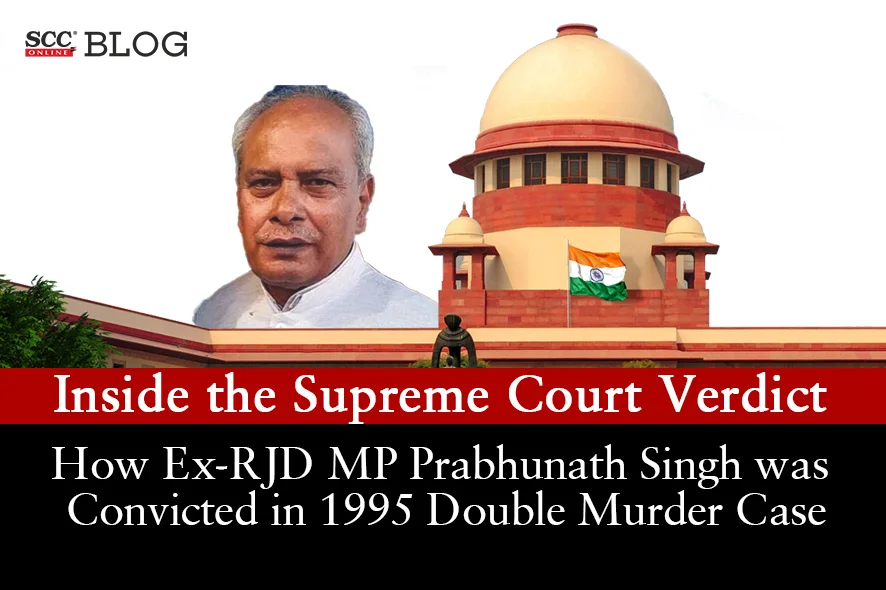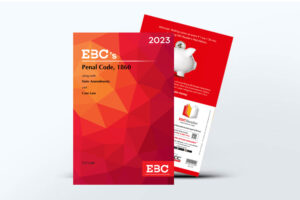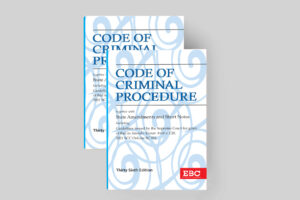Supreme Court: “The three main stake holders in a criminal trial, namely the Investigating Officer that is the part of the police of the State of Bihar, the Public Prosecutor, and the Judiciary, have all utterly failed to keep up their respective duties and responsibilities cast upon them.”
This is what the 3-judge bench of Sanjay Kishan Kaul, Abhay S. Oka and Vikram Nath, JJ had to say while reversing the acquittal of ex-RJD MP Prabhunath Singh in a double murder case. The Court went on to convict Prabhunath Singh under Sections 302 and 307 IPC for committing culpable homicide amounting to murder and attempt to murder and directed him to be taken into custody and be produced before the Court on 01.09.2023 to decide the quantum of sentence.
1995 Double Murder: A Sitting MP’s Power Play and One Glaring Mistake that led to his Downfall
“Everything was going as per the plan and wish of the main accused Prabhunath Singh, a political leader and a sitting Member of Parliament at the relevant time as he had mustered full support of the Administration and the Investigating Agency; he had influenced and won over almost all the witnesses of fact mentioned in the chargesheet (who were declared hostile), the relevant formal witnesses including the Investigating Officer were not produced in the trial by the prosecution, the Public Prosecutor prosecuting the case was supporting the defence, the Presiding Officers were completely insensitive towards their pious duty, but everything turned upside down when he committed a glaring mistake and that one mistake cost him heavily.”
-
In 1995, during an election, ex-RJD MP Prabhunath Singh, a contesting candidate for Bihar People’s Party, opened fire on a group of people who had cast their votes for the Janta Dal Party. Three people were injured, out of which 2 succumbed to their injuries.
-
Prabhunath Singh’s political power ensured everything went according to his plan and he, initially, successfully avoided arrest as he was the member of the ruling party. Due to the influence of the accused, Prabhunath Singh, the District Magistrate recommended that six cases, in which he was an accused, be transferred to Hazaribagh from District Saran at Chapra. The transfer was approved by the High Court. However, after the re-organization of the State of Bihar in 2000, the trial was transferred to District Bhagalpur.
-
It took 11 years for charges to be framed against all the accused for various offenses under IPC and and in 2006, 11 witnesses were examined. Out of these 11 witnesses, the statement of 7 witnesses were more or less similar to the effect that they saw the incident of firing but did not see who killed the 2 deceased. All 7 witnesses were declared hostile by the Prosecution.
-
A few months later, the mother of one of the deceased, was summoned as a court witness but she, along with her husband, was abducted by the brother of Prabhunath Singh and his associates. before her statement could be recorded.
-
This led to a Habeas Corpus petition being filed before the Patna High Court, a report submitted by the Inspecting Judge as a result of an unruly incident which occurred in the Trial Court on the date the mother of deceased deposed before the Trial Court and another report of the Inspecting Judge commenting upon the judgment of acquittal by the Trial Court
Lapses Found in Prosecution and Investigating Agency Conduct
a) No explanation was given for not producing the scribe of the FIR. In case the scribe was not available for some reason then someone else from the police station could have been produced to prove the hand writing and signature of the scribe.
b) The Investigating Officer not produced by the prosecution, is again a clear and deliberate lapse.
c) Non-production of other prosecution witnesses of preparing the recovery/seizure list, inquest report, carrying the dead-body to the hospital, and absence of any effort to prove other formal aspects of the investigation clearly indicate malice and deliberate lapse on the part of the prosecution.
d) The conduct of the Public Prosecutor in filing affidavits in evidence of the witnesses of fact despite directions of the High Court and further examining witnesses under 311 CrPC to strengthen the case of defence reflects the tainted role of the Public Prosecutor.
Trial Court and Patna High Court’s failure to notice the sensitivity and intricacies of the case
The Trial Court acquitted Prabhunath Singh and the High Court dismissed the revision. They did so while being well aware of the facts, legal procedures, as well as the law regarding appreciation of evidence in a criminal case. On this, the Supreme Court observed that both the Courts failed to exercise their powers under the aforesaid provisions to summon the witnesses of the charge-sheet to prove the police papers. Despite applications being filed to summon persons who were not shown as witnesses to the charge-sheet, the Trial Court repeatedly rejected the said applications in 2006 and again in 2008 on the flimsy grounds that were not named in the charge-sheet or that the Public Prosecutor had not filed such application in gross violation of Section 311 CrPC.
“Section 311 CrPC confers wide powers on any court at any stage of any inquiry, trial or other proceeding under this Code to summon material witness or examine person present. Such person may not be a person summoned as a witness. Power to recall and re-examine is also vested. The concept is that it should be essential for the just decision of the case.”
Miserably failing to notice the sensitivity and intricacies of the case, both the Courts completely shut their eyes to the manner of the investigation, the Prosecutor’s role, and the highhandedness of the accused.
“They continued with their classical rut of dealing with the evidence in a manner as if it was a normal trial. They failed to notice the conduct of the Public Prosecutor in not even examining the formal witnesses and also that the Public Prosecutor was acting to the advantage of the accused rather than prosecuting the accused with due diligence and honesty.”
Dying Declaration of one of the Deceased
One of the deceased, who succumbed to his injuries 5 months after the incident, gave his statement in the form of Bayan Tahriri and narrated the entire incident and circumstances of the transaction which resulted in his death. This fact is not in dispute and hence, the FIR lodged on the basis of his Bayan Tahrir is liable to be treated as a dying declaration, which itself is a substantive piece of evidence and is admissible under Section 32(1) of the Evidence Act.
Admissibility of statement of deceased’s mother who was abducted before her statement could be recorded
The Patna High Court, in its impugned judgement, concluded that deceased’s mother is not a hearsay witness, as held by the Trial Court, but is a tutored witness in view of her last two lines in cross-examination i.e. “her son (another alive son) had asked her to take the name of accused before the Court,”
The Supreme Court held that this conclusion drawn by the High Court was unacceptable and suffered from a serious error of law and also an error of fact. “The High Court has completely failed to take up the merit of the case in its right perspective and failed to take note of the sensitivity attached to the case.”
The Court observed that the woman was under continuous threat and fear of facing dire consequence, which is apparent on the face of the record. Under these circumstances, in case she had stated in the end of her cross-examination that her son had asked her to take the name of the accused before the Trial Court, there is nothing so contradictory or surprising so as to treat the rest of the substantive ocular evidence as tutored one. Further, there is no serious discrepancy or variation in her testimony with regard to the sequence of events that occurred during the incident in question. When the entire family of was facing so many storms, it is quite natural for a son to say to her mother (who was old, illiterate, rustic woman having faced immense trauma) that she should not forget to disclose the name of accused persons, in as much as the second occasion of her examination, as ordered by the Division Bench of High Court under Section 311 of CrPC, was the last opportunity for her to speak the truth before the Trial Court.
“A witness like her cannot be expected to possess a photographic memory and to recall the details of an incident. The variations of trivial nature in her testimony are liable to be ignored.”
Sum and Substance
a) Fard Bayan of one of the deceased, which was later converted into an FIR, is admissible in evidence and is to be read as a dying declaration or his last statement.
b) The tainted investigation shows the highhandedness of Prabhunath Singh, who was a powerful person, being a sitting M.P. of the Ruling Party in the State.
c) The prosecution had established, even through the hostile witnesses, that the date, time, and place of incidence as given in the Fard Bayan of the deceased were fully established. The only issue was with regard to the identity of the assailants.
d) The post-mortem reports, show that the death of deceased was homicidal in nature. The medico legal reports supported the prosecution’s story to the extent that the injuries were caused by a fire arm, which proved fatal for two out of the three injured.
e) Adverse inference against Prabhunath Singh is drawn in view of their subsequent conduct of abduction of the mother of one of the deceased before her statement could be recorded.
f) Judicial notice is taken of the judgment in the Habeas Corpus petition dated 13.07.2007 regarding the conduct of Prabhunath Singh, the investigating agency, the Public Prosecutor and the Presiding Officer conducting the trial.
g) The two administrative reports of the respective judges, who were constitutional functionaries, also have to be given due credence and cannot be ignored outright regarding the conduct of the accused, public prosecutor and the Presiding Officer conducting the Trial.
h) The statement of deceased’s mother found to be reliable, and the Courts below wrongly discarded it on the ground that it was hearsay and tutored.
i) The dying declaration and the statement of his mother fully establish that it was Prabhunath Singh, who had caused the injuries from his firearm weapon, which proved to be fatal for two out of the three injured and also caused injury to the third surviving injured.
Hence, Prabhunath Singh is liable to be convicted under Sections 302 and 307 IPC for committing culpable homicide amounting to murder and attempt to murder. The acquittal of rest of the accused not disturbed, although named in the chargesheet after due investigation, since their names were not reflected either in the Fard Bayan of the deceased or in the statement of his mother.
[Harendra Rai v. State of Bihar, 2023 SCC OnLine SC 1023, decided on 18.08.2023]
Judgment authored by Justice Vikram Nath
Advocates who appeared in this case :
For Appellant(s): Mr. Abhay Kumar, AOR Mr. Rajat Khattry, Adv. Mr. Shagun Ruhil, Adv. Ms. Neetu Jain, Adv. Ms. Kusum Pandey, Adv. Mr. Saurabh Mishra, Adv. Ms. Anamika, Adv.;
For Respondent(s): Mr. Devashish Bharuka, AOR [Not present] Mr. Sunny Choudhary, AOR [Not present].
Buy Penal Code, 1860 HERE
Buy Code of Criminal Procedure, 1973 HERE
Image Source: millenniumpost.in









